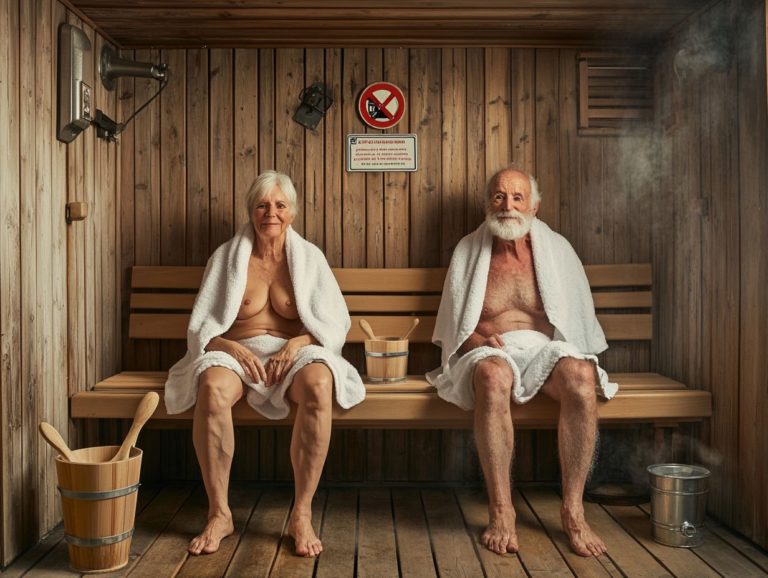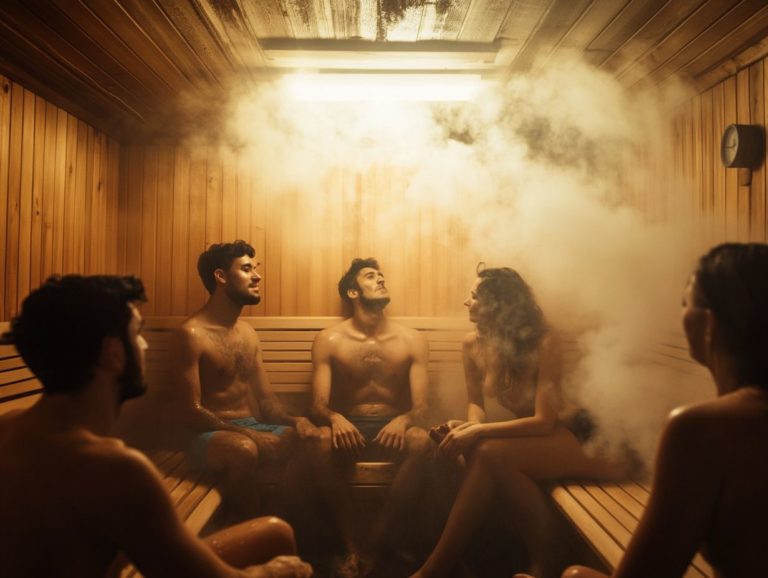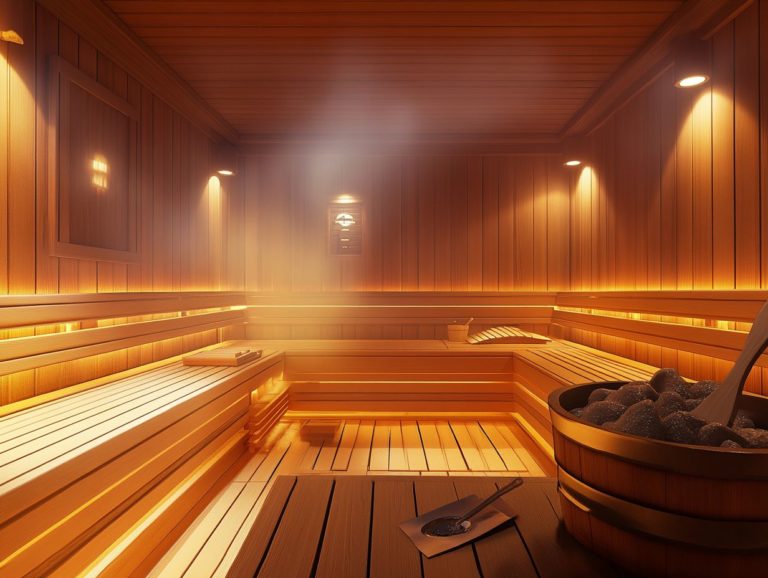Sauna Safety: Emphasizing Personal Responsibility
Saunas offer a luxurious escape and provide a wealth of health benefits. These benefits include improved circulation throughout the body due to heat exposure and enhanced skin health through detoxification, an essential aspect of sauna therapy that elevates your well-being.
Understanding sauna safety is crucial for maximizing your enjoyment while minimizing potential risks. This includes monitoring dehydration and blood pressure fluctuations during sauna sessions. In this article, get ready to uncover the amazing world of saunas, explore possible physical hazards, and highlight the dangers of dehydration while underscoring the importance of self-monitoring.
You ll discover essential tips for safe usage and specific considerations for vulnerable populations, including children and pregnant women. Dive into how you can indulge in the sauna experience safely and responsibly, ensuring that it remains a rejuvenating retreat.
Contents
- Key Takeaways:
- Understanding Sauna Safety
- Potential Risks of Sauna Use
- Personal Responsibility in Sauna Safety
- Tips for Sauna Safety
- Sauna Safety for Specific Populations
- Frequently Asked Questions
- Q: What is sauna safety and why is personal responsibility important?
- Q: How can I ensure my personal safety in a sauna?
- Are there any specific health conditions that may prevent me from using a sauna?
- Can I bring my children into the sauna?
- What should I do if I experience dizziness or lightheadedness while in the sauna?
- Is it safe to use a sauna after consuming alcohol?
Key Takeaways:

- Always know the safety rules to enjoy the sauna worry-free!
- Taking personal responsibility is essential for maintaining safety in the sauna, including monitoring your body and staying hydrated.
- Pay special attention to sauna safety for vulnerable populations, like children and pregnant women.
Understanding Sauna Safety
Understanding sauna safety is crucial, whether you are a novice or an experienced user. Recently, the popularity of infrared saunas has soared due to their role in promoting muscle relaxation and facilitating better recovery after workouts, thanks to the myriad of health benefits they offer.
Infrared saunas use special lights that heat your body without warming the air around you. This type of sauna penetrates deeper into muscles for effective recovery, promotes muscle relaxation, enhances circulation, detoxifies the body, and improves skin health, making sauna therapy an enticing wellness practice.
However, it’s essential to remain mindful of potential safety concerns. Risks such as dehydration and fluctuations in blood pressure should be acknowledged to ensure your experience is enjoyable and safe.
What is a Sauna?
A sauna is your personal oasis, a small room carefully built to envelop you in warmth, offering a serene space for relaxation and numerous therapeutic benefits. There are various types to explore, from traditional steam saunas to modern infrared options, each with its unique heating method.
Traditional steam saunas harness the power of heated rocks to create a warm, humid atmosphere. This enhances respiratory health and encourages detoxification through the power of sweating. Conversely, infrared saunas employ advanced infrared panels that emit radiant heat, penetrating deeper into your skin for a gentler yet equally effective experience. This makes them perfect for relaxation and muscle recovery.
If you enjoy versatility, full-spectrum saunas that combine various heat therapies offer both traditional and infrared methods. This allows you to tailor your wellness session to your specific preferences and needs. Each type not only elevates relaxation but also supports cardiovascular health and alleviates stress, making them increasingly popular among health enthusiasts.
Potential Risks of Sauna Use
While you can enjoy numerous health benefits from saunas, it s essential to recognize the potential risks that come with their use. These include dehydration, fluctuations in blood pressure, and various health conditions that may impact individuals differently, particularly those with preexisting health concerns.
Staying informed allows you to fully appreciate the sauna experience while prioritizing your well-being.
Physical Risks

When considering sauna use, it s essential to be aware of the physical risks associated with it, particularly dehydration and fluctuations in blood pressure. If not managed properly, these factors can diminish the myriad health benefits that saunas offer.
As you bask in the warmth of the sauna, you may find yourself sweating profusely. This leads to a considerable loss of fluids.
Without taking appropriate precautions, this can easily result in dehydration. Watch for symptoms like dizziness, dry mouth, fatigue, and an increased heart rate; these indicators suggest that your body is running low on vital fluids.
It s crucial to hydrate before entering the sauna and to replenish those fluids afterward. Staying well-hydrated helps you maintain your body balance, ensuring that your sauna experience remains enjoyable, safe, and ultimately beneficial.
Hydration and Heat Stress
Hydration is an essential pillar of sauna safety. Overlooking it can lead to heat stress, which poses significant health risks.
Sauna users need to understand the unique benefits and risks of different sauna types. Many may be unaware of the risks of dehydration from spending too long in infrared heat.
To ensure a safe and enjoyable experience, it s vital to hydrate adequately both before and after your sauna session. Sipping on water or electrolyte-rich beverages beforehand prepares your body for the intense heat.
Always pay attention to signs like dizziness or a rapid heartbeat; these can signal the onset of heat stress. Taking breaks during longer sessions allows your body to cool down and rehydrate effectively.
By incorporating these strategies, you can relish the benefits of your sauna sessions while minimizing the risks associated with dehydration and excessive heat exposure.
Personal Responsibility in Sauna Safety
Personal responsibility is paramount for ensuring sauna safety. As a sauna user, you should actively engage in self-monitoring throughout your sessions.
Using relaxation techniques can enhance your sauna experience. They help you effectively assess your comfort levels and overall well-being, allowing you to reap the myriad health benefits that sauna therapy offers.
Importance of Self-Monitoring
Self-monitoring is essential for your sauna safety. It allows you to respond adeptly to your body s signals and fully embrace the health benefits of sauna therapy without compromising your well-being.
To achieve this, regularly check your body temperature before and after sauna sessions. Consider using a personal thermometer for accurate readings.
Staying mindful of your hydration levels is just as crucial. Keeping water within reach encourages you to sip at regular intervals, ensuring you remain well-hydrated.
Pay attention to how your body feels. Whether you’re experiencing warmth, excessive sweating, or any discomfort, this awareness will help you decide when it s time to exit the sauna.
By being attentive to these factors, you not only protect your health but also enhance your relaxation. Understanding sauna safety helps transform each sauna session into a truly rejuvenating experience.
Tips for Sauna Safety

Implementing effective sauna safety tips is crucial for ensuring a positive experience. You should adopt the right precautions, prioritize hydration, and practice relaxation techniques to truly maximize the health benefits that sauna therapy offers.
Follow these tips to enjoy a safe and refreshing sauna journey today!
Proper Precautions and Hydration
Proper precautions and hydration are essential for sauna users. Staying hydrated helps mitigate dehydration risks and ensures your experience is both safe and enjoyable. This enhances the myriad health benefits that infrared saunas offer and elevates your overall well-being.
Before entering the sauna, it s wise to hydrate thoroughly, preparing your body for the heat. If you’ve just had a heavy meal, give yourself at least 15 minutes before stepping inside. This allows your digestive system to settle and makes for a more comfortable experience.
During your session, pay close attention to how your body feels. If you start to feel dizzy or overheated, exit immediately. Your safety is paramount.
After your sauna experience, rehydration is crucial. Quenching your thirst with water or electrolyte-rich beverages supports your recovery. Take your time allowing your body to cool down gradually to avoid sudden temperature changes and promote overall well-being.
Sauna Safety for Specific Populations
Sauna safety is especially important for certain groups, such as children and pregnant women. They face distinct risks when using a sauna, underscoring the need for specific precautions and guidelines tailored to their needs.
Risks for Children and Pregnant Women
Children and pregnant women encounter unique risks when using saunas. It’s crucial to understand how heat exposure affects their health and well-being. This shows why it’s important to follow sauna safety rules.
For example, children are typically more sensitive to heat than adults. Extended exposure can lead to dehydration, heat exhaustion, or even heat stroke. Pregnant women must also be cautious, as elevated body temperatures can jeopardize fetal development and potentially lead to complications like neural tube defects a type of birth defect affecting the brain and spine.
To ensure safety, parents and expectant mothers should consider the following guidelines:
- Limit exposure time to no more than 10 minutes.
- Ensure proper hydration before and after the sauna session.
- Consult with a healthcare provider beforehand.
Creating a cooler environment within the sauna and staying vigilant for any signs of discomfort can help mitigate these risks.
Frequently Asked Questions

Q: What is sauna safety and why is personal responsibility important?
A: Sauna safety involves guidelines to keep you safe while using a sauna. Personal responsibility is crucial because it empowers you to take charge of your own safety and avoid potential risks.
Q: How can I ensure my personal safety in a sauna?
A: To ensure your personal safety, follow basic precautions such as limiting your sauna sessions to a maximum of 15-20 minutes, staying hydrated, and avoiding alcohol and drugs before or during sauna use. Pay attention to your body’s signals and exit the sauna immediately if you feel uncomfortable or unwell.
Are there any specific health conditions that may prevent me from using a sauna?
Yes, if you have heart disease, low blood pressure, or are pregnant, consult your doctor before using a sauna. It’s also best to avoid sauna use if you have open wounds, infections, or have had recent surgery.
Can I bring my children into the sauna?
Children under 18 should not use a sauna without adult supervision. Limit their sauna sessions to 5-10 minutes and ensure they drink enough water.
Always consider your child’s health and any medical conditions before bringing them into a sauna.
What should I do if I experience dizziness or lightheadedness while in the sauna?
If you feel dizzy or lightheaded, exit the sauna immediately and cool down. Drink water and rest until you feel better. If symptoms continue, seek medical attention.
Is it safe to use a sauna after consuming alcohol?
No, it’s not safe to use a sauna after drinking alcohol. Alcohol can dehydrate you and affect your body’s temperature control, which may be dangerous in a sauna.
It’s best to avoid alcohol before and during sauna use to keep yourself safe!






